第二章管理学原理习题参考答案
- 格式:doc
- 大小:203.50 KB
- 文档页数:10
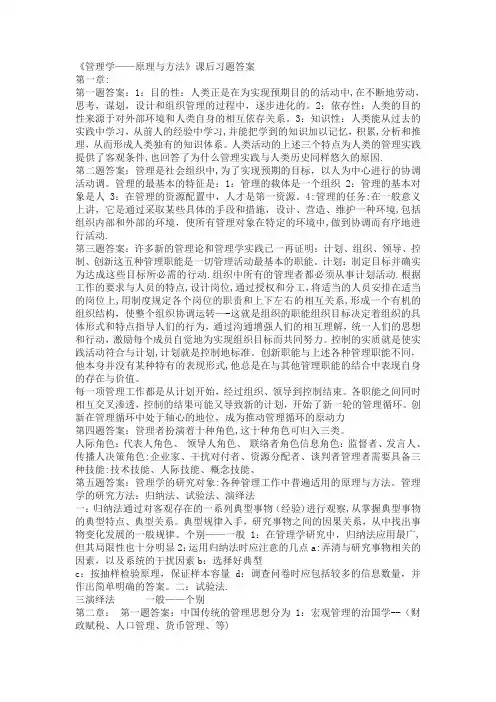
《管理学——原理与方法》课后习题答案第一章:第一题答案:1:目的性:人类正是在为实现预期目的的活动中,在不断地劳动,思考,谋划,设计和组织管理的过程中,逐步进化的。
2:依存性:人类的目的性来源于对外部环境和人类自身的相互依存关系。
3:知识性:人类能从过去的实践中学习,从前人的经验中学习,并能把学到的知识加以记忆,积累,分析和推理,从而形成人类独有的知识体系。
人类活动的上述三个特点为人类的管理实践提供了客观条件,也回答了为什么管理实践与人类历史同样悠久的原因.第二题答案:管理是社会组织中,为了实现预期的目标,以人为中心进行的协调活动调。
管理的最基本的特征是:1:管理的载体是一个组织2:管理的基本对象是人3:在管理的资源配置中,人才是第一资源。
4:管理的任务:在一般意义上讲,它是通过采取某些具体的手段和措施,设计、营造、维护一种环境,包括组织内部和外部的环境,使所有管理对象在特定的环境中,做到协调而有序地进行活动.第三题答案:许多新的管理论和管理学实践已一再证明:计划、组织、领导、控制、创新这五种管理职能是一切管理活动最基本的职能。
计划:制定目标并确实为达成这些目标所必需的行动.组织中所有的管理者都必须从事计划活动.根据工作的要求与人员的特点,设计岗位,通过授权和分工,将适当的人员安排在适当的岗位上,用制度规定各个岗位的职责和上下左右的相互关系,形成一个有机的组织结构,使整个组织协调运转—-这就是组织的职能组织目标决定着组织的具体形式和特点指导人们的行为,通过沟通增强人们的相互理解,统一人们的思想和行动,激励每个成员自觉地为实现组织目标而共同努力。
控制的实质就是使实践活动符合与计划,计划就是控制地标准。
创新职能与上述各种管理职能不同,他本身并没有某种特有的表现形式,他总是在与其他管理职能的结合中表现自身的存在与价值。
每一项管理工作都是从计划开始,经过组织、领导到控制结束。
各职能之间同时相互交叉渗透,控制的结果可能又导致新的计划,开始了新一轮的管理循环。
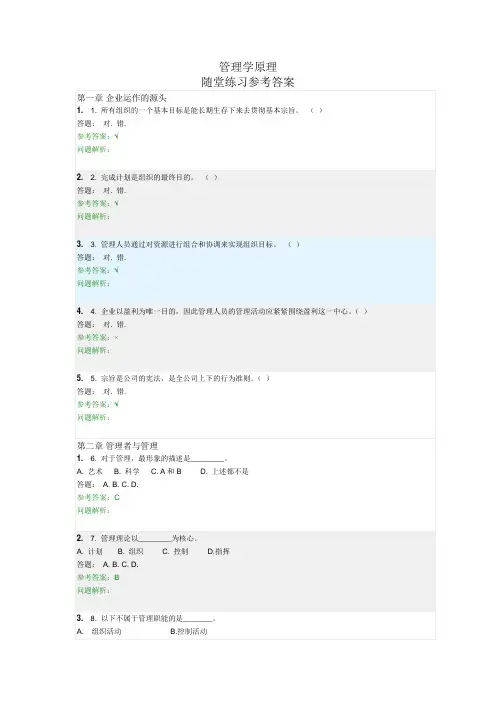
管理学原理随堂练习参考答案第一章企业运作的源头1. 1. 所有组织的一个基本目标是能长期生存下来去贯彻基本宗旨。
()答题:对. 错.参考答案:√问题解析:2. 2. 完成计划是组织的最终目的。
()答题:对. 错.参考答案:√问题解析:3. 3. 管理人员通过对资源进行组合和协调来实现组织目标。
()答题:对. 错.参考答案:√问题解析:4. 4. 企业以盈利为唯一目的,因此管理人员的管理活动应紧紧围绕盈利这一中心。
()答题:对. 错.参考答案:×问题解析:5. 5. 宗旨是公司的宪法,是全公司上下的行为准则。
()答题:对. 错.参考答案:√问题解析:第二章管理者与管理1. 6. 对于管理,最形象的描述是________。
A. 艺术B. 科学C. A和BD. 上述都不是答题: A. B. C. D.参考答案:C问题解析:2.7. 管理理论以________为核心。
A. 计划B. 组织C. 控制D.指挥答题: A. B. C. D.参考答案:B问题解析:3.8. 以下不属于管理职能的是_______。
A. 组织活动B.控制活动C. 有效获取资源D.计划与决策答题: A. B. C. D.参考答案:C问题解析:4.9. 管理者应该承担哪种类型的角色_______。
A.人际关系方面的角色B.信息方面的角色C.决策方面的角色D.全部皆是答题: A. B. C. D.参考答案:D问题解析:5.10. 法约尔所提出的企业6项经营职能是指:技术职能、营业职能、财务职能、保养职能、会计职能、安全职能。
()答题:对. 错.参考答案:×问题解析:6.11. 按照现代的观点,管理的职能包括计划、组织、领导和控制。
()答题:对. 错.参考答案:√问题解析:7.12. 法约尔提出的管理职能中包括了指挥、协调两大职能,现代理论则以领导取而代之。
()答题:对. 错.参考答案:√问题解析:8.13. 泰勒教授提出,管理就是决策。
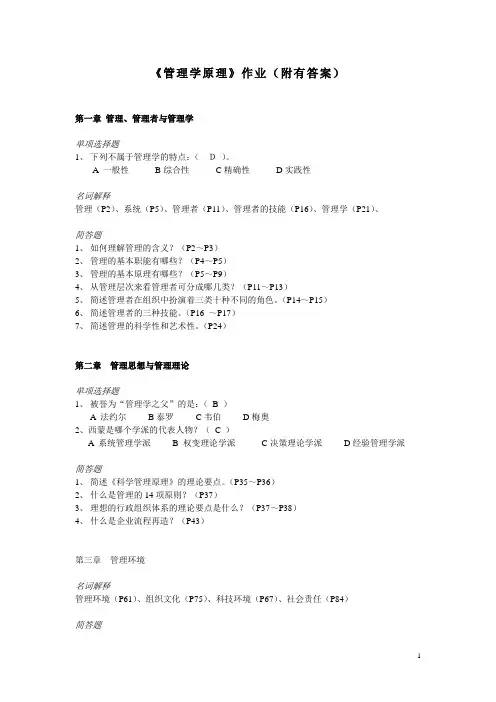
《管理学原理》作业(附有答案)第一章管理、管理者与管理学单项选择题1、下列不属于管理学的特点:(D)。
A 一般性B综合性C精确性D实践性名词解释管理(P2)、系统(P5)、管理者(P11)、管理者的技能(P16)、管理学(P21)、简答题1、如何理解管理的含义?(P2~P3)2、管理的基本职能有哪些?(P4~P5)3、管理的基本原理有哪些?(P5~P9)4、从管理层次来看管理者可分成哪几类?(P11~P13)5、简述管理者在组织中扮演着三类十种不同的角色。
(P14~P15)6、简述管理者的三种技能。
(P16 ~P17)7、简述管理的科学性和艺术性。
(P24)第二章管理思想与管理理论单项选择题1、被誉为“管理学之父”的是:(B )A 法约尔B泰罗C韦伯D梅奥2、西蒙是哪个学派的代表人物?(C )A 系统管理学派B 权变理论学派C决策理论学派D经验管理学派简答题1、简述《科学管理原理》的理论要点。
(P35~P36)2、什么是管理的14项原则?(P37)3、理想的行政组织体系的理论要点是什么?(P37~P38)4、什么是企业流程再造?(P43)第三章管理环境名词解释管理环境(P61)、组织文化(P75)、科技环境(P67)、社会责任(P84)简答题1、简述管理环境的构成。
(P63)2、组织如何适应环境?(P71~P72)3、简述组织文化的特点。
(P76~P77)4、简述组织文化的功能。
(P77)5、组织文化如何影响管理?(P78~P79)6、如何建设组织文化?(P82~P83)第四章决策单项选择题1、下列哪个不属于决策的特点?( B )A超前性B适时性C目标确定性D风险性名词解释决策(P95)、德尔菲法(P101)简答题1、简述决策的内涵。
(P95)2、决策有哪些步骤?(P99~P100)3、悲观决策法、乐观决策法与最小后悔值法有什么区别?(P106)4、如何避免决策的失误?(P110~P111)计算题课本例题4.2、例题4.4第五章计划名词解释计划(P117)、宗旨(P121)、战略(P122)、滚动计划法(P129)、目标管理(P132)简答题1、简述计划的特征。

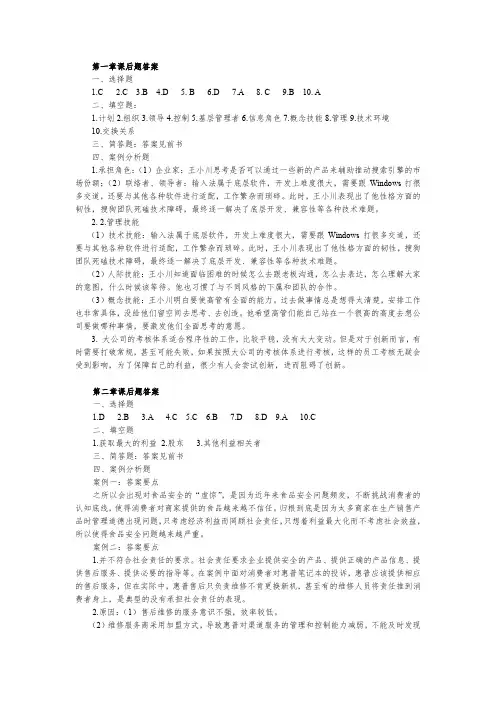
第一章课后题答案一、选择题1.C2.C3.B4.D5. B6.D7.A8. C9.B 10. A二、填空题:1.计划2.组织3.领导4.控制5.基层管理者6.信息角色7.概念技能8.管理9.技术环境10.交换关系三、简答题:答案见前书四、案例分析题1.承担角色:(1)企业家:王小川思考是否可以通过一些新的产品来辅助推动搜索引擎的市场份额;(2)联络者、领导者:输入法属于底层软件,开发上难度很大,需要跟Windows打很多交道,还要与其他各种软件进行适配,工作繁杂而琐碎。
此时,王小川表现出了他性格方面的韧性,搜狗团队死磕技术障碍,最终逐一解决了底层开发、兼容性等各种技术难题。
2. 2.管理技能(1)技术技能:输入法属于底层软件,开发上难度很大,需要跟Windows打很多交道,还要与其他各种软件进行适配,工作繁杂而琐碎。
此时,王小川表现出了他性格方面的韧性,搜狗团队死磕技术障碍,最终逐一解决了底层开发、兼容性等各种技术难题。
(2)人际技能:王小川知道面临困难的时候怎么去跟老板沟通,怎么去表达,怎么理解大家的意图,什么时候该等待。
他也习惯了与不同风格的下属和团队的合作。
(3)概念技能:王小川明白要使高管有全面的能力。
过去做事情总是想得太清楚,安排工作也非常具体,没给他们留空间去思考、去创造。
他希望高管们能自己站在一个很高的高度去想公司要做哪种事情,要激发他们全面思考的意愿。
3. 大公司的考核体系适合程序性的工作,比较平稳,没有太大变动。
但是对于创新而言,有时需要打破常规,甚至可能失败,如果按照大公司的考核体系进行考核,这样的员工考核无疑会受到影响,为了保障自己的利益,很少有人会尝试创新,进而阻碍了创新。
第二章课后题答案一、选择题1.D2.B3.A4.C5.C6.B7.D8.D9.A 10.C二、填空题1.获取最大的利益2.股东3.其他利益相关者三、简答题:答案见前书四、案例分析题案例一:答案要点之所以会出现对食品安全的“虚惊”,是因为近年来食品安全问题频发,不断挑战消费者的认知底线,使得消费者对商家提供的食品越来越不信任。
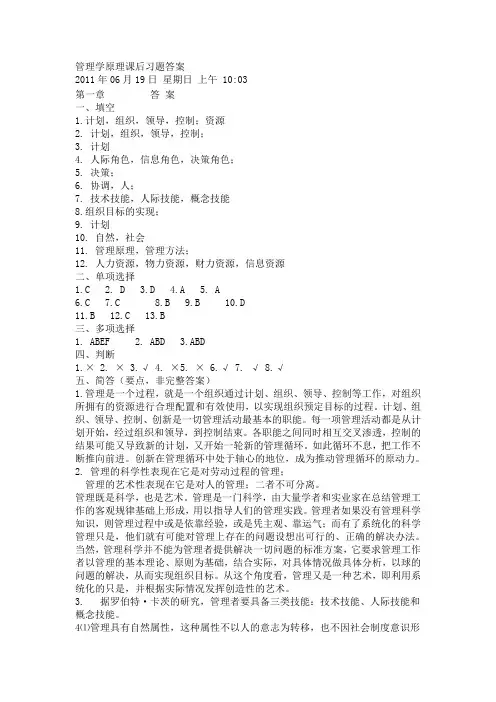
管理学原理课后习题答案2011年06月19日星期日上午 10:03第一章答案一、填空1.计划,组织,领导,控制;资源2. 计划,组织,领导,控制;3. 计划4. 人际角色,信息角色,决策角色;5. 决策;6. 协调,人;7. 技术技能,人际技能,概念技能8.组织目标的实现;9. 计划10. 自然,社会11. 管理原理,管理方法;12. 人力资源,物力资源,财力资源,信息资源二、单项选择1.C2. D3.D4.A5. A6.C7.C8.B9.B 10.D11.B 12.C 13.B三、多项选择1. ABEF2. ABD3.ABD四、判断1.×2. ×3.√4. ×5. ×6.√7. √8.√五、简答(要点,非完整答案)1.管理是一个过程,就是一个组织通过计划、组织、领导、控制等工作,对组织所拥有的资源进行合理配置和有效使用,以实现组织预定目标的过程。
计划、组织、领导、控制、创新是一切管理活动最基本的职能。
每一项管理活动都是从计划开始,经过组织和领导,到控制结束。
各职能之间同时相互交叉渗透,控制的结果可能又导致新的计划,又开始一轮新的管理循环。
如此循环不息,把工作不断推向前进。
创新在管理循环中处于轴心的地位,成为推动管理循环的原动力。
2. 管理的科学性表现在它是对劳动过程的管理;管理的艺术性表现在它是对人的管理;二者不可分离。
管理既是科学,也是艺术。
管理是一门科学,由大量学者和实业家在总结管理工作的客观规律基础上形成,用以指导人们的管理实践。
管理者如果没有管理科学知识,则管理过程中或是依靠经验,或是凭主观、靠运气;而有了系统化的科学管理只是,他们就有可能对管理上存在的问题设想出可行的、正确的解决办法。
当然,管理科学并不能为管理者提供解决一切问题的标准方案,它要求管理工作者以管理的基本理论、原则为基础,结合实际,对具体情况做具体分析,以球的问题的解决,从而实现组织目标。
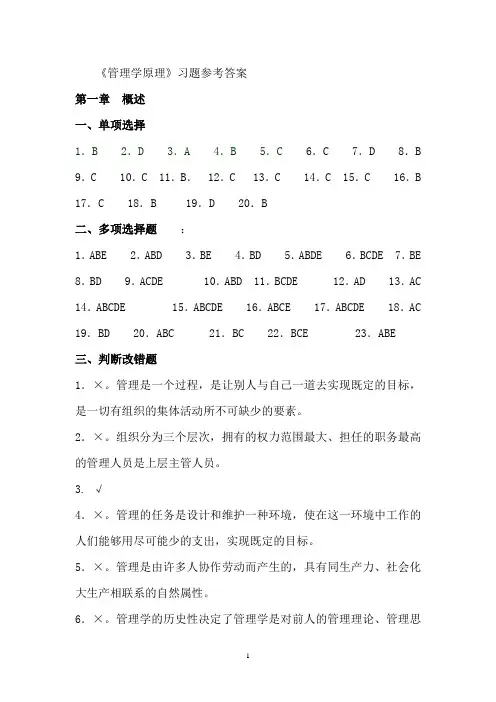
《管理学原理》习题参考答案第一章概述一、单项选择1.B 2.D 3.A 4.B 5.C 6.C 7.D 8.B 9.C 10.C 11.B. 12.C 13.C 14.C 15.C 16.B 17.C 18.B 19.D 20.B二、多项选择题:1.ABE 2.ABD 3.BE 4.BD 5.ABDE 6.BCDE 7.BE 8.BD 9.ACDE 10.ABD 11.BCDE 12.AD 13.AC 14.ABCDE 15.ABCDE 16.ABCE 17.ABCDE 18.AC 19.BD 20.ABC 21.BC 22.BCE 23.ABE 三、判断改错题1.×。
管理是一个过程,是让别人与自己一道去实现既定的目标,是一切有组织的集体活动所不可缺少的要素。
2.×。
组织分为三个层次,拥有的权力范围最大、担任的职务最高的管理人员是上层主管人员。
3. √4.×。
管理的任务是设计和维护一种环境,使在这一环境中工作的人们能够用尽可能少的支出,实现既定的目标。
5.×。
管理是由许多人协作劳动而产生的,具有同生产力、社会化大生产相联系的自然属性。
6.×。
管理学的历史性决定了管理学是对前人的管理理论、管理思想的总结、扬弃和发展。
7.×。
研究如何完善组织机构与各种管理体制的问题是管理学内生产关系方面的内容。
8.√9.√四、名词解释(答案略)五、简答题1.管理是一个过程,是让别人与自己一道去实现既定的目标,是一切有组织的集体活动所不可缺少的要素。
管理的基本特征是:(1)管理是一种文化或社会现象。
其存在的必要条件,一是多人集体活动;二是共同一致目标。
这就使组织成为管理的载体。
(2)管理的主体是管理者。
他的责任是管理组织、管理管理者、管理工作和工人。
(3)管理具有特定任务,职能和层次。
即通过上、中、基层三个层次,运用计划、组织、人员配备、指导与领导、控制等基本职能,设计和维持一种体系,使共同工作的人以尽量少的支出,实现既定目标。
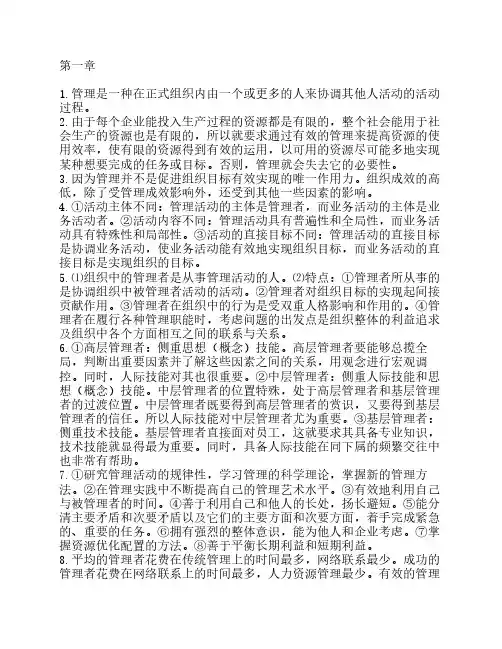
第一章1.管理是一种在正式组织内由一个或更多的人来协调其他人活动的活动过程。
2.由于每个企业能投入生产过程的资源都是有限的,整个社会能用于社会生产的资源也是有限的,所以就要求通过有效的管理来提高资源的使用效率,使有限的资源得到有效的运用,以可用的资源尽可能多地实现某种想要完成的任务或目标。
否则,管理就会失去它的必要性。
3.因为管理并不是促进组织目标有效实现的唯一作用力。
组织成效的高低,除了受管理成效影响外,还受到其他一些因素的影响。
4.①活动主体不同:管理活动的主体是管理者,而业务活动的主体是业务活动者。
②活动内容不同:管理活动具有普遍性和全局性,而业务活动具有特殊性和局部性。
③活动的直接目标不同:管理活动的直接目标是协调业务活动,使业务活动能有效地实现组织目标,而业务活动的直接目标是实现组织的目标。
5.⑴组织中的管理者是从事管理活动的人。
⑵特点:①管理者所从事的是协调组织中被管理者活动的活动。
②管理者对组织目标的实现起间接贡献作用。
③管理者在组织中的行为是受双重人格影响和作用的。
④管理者在履行各种管理职能时,考虑问题的出发点是组织整体的利益追求及组织中各个方面相互之间的联系与关系。
6.①高层管理者:侧重思想(概念)技能。
高层管理者要能够总揽全局,判断出重要因素并了解这些因素之间的关系,用观念进行宏观调控。
同时,人际技能对其也很重要。
②中层管理者:侧重人际技能和思想(概念)技能。
中层管理者的位置特殊,处于高层管理者和基层管理者的过渡位置。
中层管理者既要得到高层管理者的赏识,又要得到基层管理者的信任。
所以人际技能对中层管理者尤为重要。
③基层管理者:侧重技术技能。
基层管理者直接面对员工,这就要求其具备专业知识,技术技能就显得最为重要。
同时,具备人际技能在同下属的频繁交往中也非常有帮助。
7.①研究管理活动的规律性,学习管理的科学理论,掌握新的管理方法。
②在管理实践中不断提高自己的管理艺术水平。
③有效地利用自己与被管理者的时间。
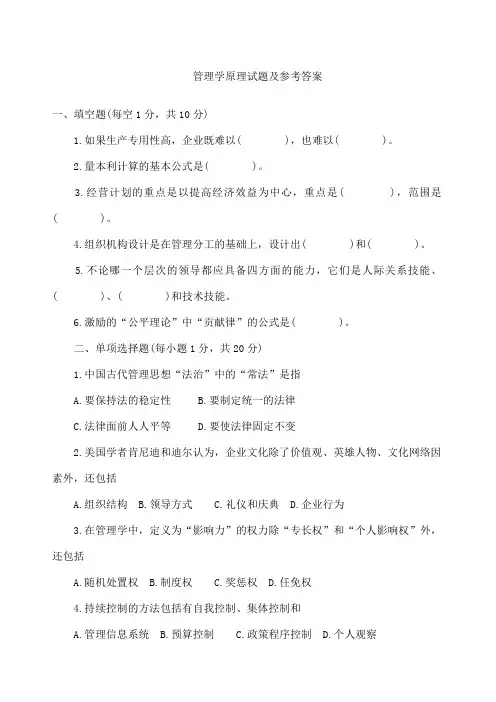
管理学原理试题及参考答案一、填空题(每空1分,共10分)1.如果生产专用性高,企业既难以( ),也难以( )。
2.量本利计算的基本公式是( )。
3.经营计划的重点是以提高经济效益为中心,重点是( ),范围是( )。
4.组织机构设计是在管理分工的基础上,设计出( )和( )。
5.不论哪一个层次的领导都应具备四方面的能力,它们是人际关系技能、( )、( )和技术技能。
6.激励的“公平理论”中“贡献律”的公式是( )。
二、单项选择题(每小题1分,共20分)1.中国古代管理思想“法治”中的“常法”是指A.要保持法的稳定性B.要制定统一的法律C.法律面前人人平等D.要使法律固定不变2.美国学者肯尼迪和迪尔认为,企业文化除了价值观、英雄人物、文化网络因素外,还包括A.组织结构B.领导方式C.礼仪和庆典D.企业行为3.在管理学中,定义为“影响力”的权力除“专长权”和“个人影响权”外,还包括A.随机处置权B.制度权C.奖惩权D.任免权4.持续控制的方法包括有自我控制、集体控制和A.管理信息系统B.预算控制C.政策程序控制D.个人观察5.群体的发展一般经历四个明显的阶段,它们是A.初创、动荡、有序、衰亡B.形成、动荡、规范、表现C.形成、有序、规范、成熟D.形成、动荡、规范、成熟6.所谓的“火炉法则”包括以下步骤A.预先警告、即时处理、违者必究、普适执行B.预先警告、即时处理、相同后果、普适执行C.预先警告、身为表率、即时处理、相同后果D.预先警告、身为表率、即时处理、普适执行7.环境研究对组织决策有着非常重要的影响,具体表现在可以提高组织决策的A.有效性、及时性、稳定性B.前瞻性、有效性、稳定性C.正确性、及时性、稳定性D.有效性、正确性、及时性8.从组织外部招聘管理人员可以带来“外来优势”是指被聘干部A.没有历史包袱B.能为组织带来新鲜空气C.可以迅速开展工作D.具有广告效应9.人员配备的工作包括A.制定工作规范,选配、培训组织成员B.确定人员需用量、选配、培训组织成员C.确定人员结构、选配、培训组织成员D.确定人员需用量、选配、考核、晋升组织成员10.所谓授权,是指A.在组织设计时,规定下属管理岗位必要的职责与权限B.在组织调整时,规定下属管理岗位必要的职责与权限C.领导者将部分处理问题的权委派给某些下属D.委托代理关系11.( )假设事物在历史上各个时期的状况对未来的影响程度是相同的。
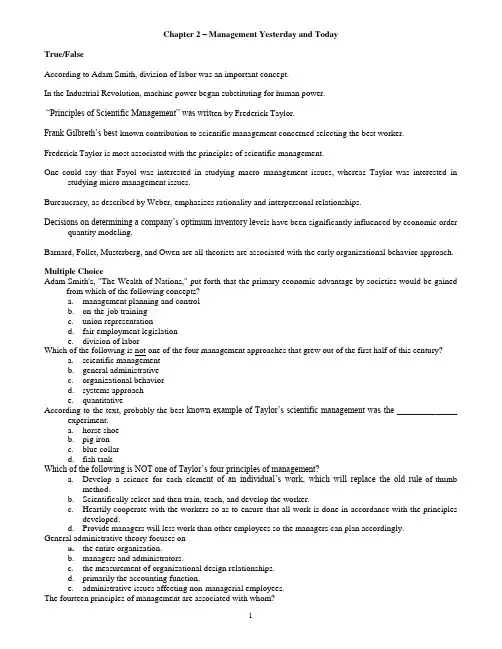
Chapter 2 – Management Yesterday and TodayTrue/FalseAccording to Adam Smith, division of labor was an important concept.In the Industrial Revolution, machine power began substituting for human power.“Principles of Scientific Management” was writ ten by Frederick Taylor.Frank Gilbreth’s best-known contribution to scientific management concerned selecting the best worker.Frederick Taylor is most associated with the principles of scientific management.One could say that Fayol was interested in studying macro management issues, whereas Taylor was interested in studying micro management issues.Bureaucracy, as described by Weber, emphasizes rationality and interpersonal relationships.Decisions on determining a company’s optimum inventory le vels have been significantly influenced by economic order quantity modeling.Barnard, Follet, Musterberg, and Owen are all theorists are associated with the early organizational behavior approach. Multiple ChoiceAdam Smith's, "The Wealth of Nations," put forth that the primary economic advantage by societies would be gained from which of the following concepts?a. management planning and controlb. on-the-job trainingc. union representationd. fair employment legislatione. division of laborWhich of the following is not one of the four management approaches that grew out of the first half of this century?a. scientific managementb. general administrativec. organizational behaviord. systems approache. quantitativeAccording to the text, probably the best-known example of Taylor’s scientific management was the ______________ experiment.a.horse shoeb.pig ironc.blue collard.fish tankWhich of the following is NOT one of Taylor’s four principles of management?a.Develop a science for each eleme nt of an individual’s work, which will replace the old rule-of-thumbmethod.b.Scientifically select and then train, teach, and develop the worker.c.Heartily cooperate with the workers so as to ensure that all work is done in accordance with the principlesdeveloped.d.Provide managers will less work than other employees so the managers can plan accordingly.General administrative theory focuses ona.the entire organization.b. managers and administrators.c. the measurement of organizational design relationships.d. primarily the accounting function.e. administrative issues affecting non-managerial employees.The fourteen principles of management are associated with whom?a. Weberb. Druckerc. Taylord. Gilbrethe. FayolWhich of the following approaches to management has also been labeled operations research or management science?a.The qualitative approachb.The quantitative approachc.The experimental approachd.The theoretical approachWhich of the following would not be associated with the quantitative approach to management?a. information modelsb. critical-path schedulingc. systematic motivation of individualsd. linear programminge. statisticsWithout question, the most important contribution to the developing field of organizational behavior came out of the _______________.a.Taylor Studies.b.Porter Studies.c.Parker Studies.d.Hawthorne Studies.What scientist is most closely associated with the Hawthorne Studies?a. Adamsb. Mayoc. Lawlerd. Barnarde. FollettOne outcome of the Hawthorne studies could be described by which of the following statements?a.Social norms are the key determinants of individual work behavior.b.Money is more important than the group on individual productivity.c.Behavior and employee sentiments are inversely related.d.Security is relatively unimportant.e.While groups are an important determinant of worker productivity, the individual him/herself is mostimportant.Scenarios and QuestionsHISTORICAL BACKGROUND OF MANAGEMENTA Look Back (Scenario)Cindy Schultz, tired from working with customers all day, decided to take a fifteen-minute nap to help clear her head before the 4:15 managers' meeting. Her company had recently begun a re-engineering process as well as other changes requiring copious management input. As she leaned back in her chair, she wondered if management science had always been this way and how it all began. As she napped, she dreamed that, along with "Mr. Peebodi" as her guide, she was traveling in the "Management Way Back Machine" that took her back through management history.106. One of the earliest sites Cindy visited was Adam Smith's home, author of The Wealth of Nations, which suggested that organizations and society would gain froma. time management.b. division of labor.c. group work.d. quality management.e. time and motion studies.107. Cindy visited a bookstore where there was a book signing occurring. She looked down and saw that the title of the book was Principles of Scientific Management and concluded that the author must bea. Adam Smith.b. Frank Gilbreth.c. Henry Gantt.d. Frederick Taylor.e. Henri Fayol.108. Cindy admired the works of Taylor and Gilbreth, two advocates ofa. scientific management.b. organizational behavior.c. human resource management.d. motivation.e. leadership.109. Cindy spent some time visiting with __________, a researcher she previously knew little about but who also contributed to management science by being among the first to use motion picture films to study hand-and-body motions and by devising a classification scheme known as a "therblig."a. Henry Ganttb. Max Weberc. Chester Barnardd. Frank Gilbrethe. Mary Parker FolletEssay QuestionsSCIENTIFIC MANAGEMENTIn a short essay, discuss Frederick Taylor’s work in scientific management. Next, list Taylor’s four principles of management.AnswerFrederick Taylor did most of his work at the Midvale and Bethlehem Steel Companies in Pennsylvania. As a mechanical engineer with a Quaker and Puritan background, he was conti nually appalled by workers’ inefficiencies. Employees used vastly different techniques to do the same job. They were inclined to “take it easy” on the job, and Taylor believed that worker output was only about one-third of what was possible.Virtually no work standards existed. Workers were placed in jobs with little or no concern for matching their abilities and aptitudes with the tasks they were required to do. Managers and workers were in continual conflict.Taylor set out to correct the situation by applying the scientific method to shop floor jobs. He spent more than two decades passionately pursuing the “one best way” for each job to be done.Taylor’s Four Principles of Managementa.Develop a science for each element of an individual’s work, whi ch will replace the old rule-of-thumbmethod.b.Scientifically select and then train, teach, and develop the worker.c.Heartily cooperate with the workers so as to ensure that al work is done in accordance with the principles ofthe science that has been developed.d.Divide work and responsibility almost equally between management and workers. Management takes overall work for which it is better fitted than the workers.(difficult)122. In a short essay, discuss the work in scientific management by Frank and Lillian Gilbreth.AnswerFrank Gilbreth is probably best known for his experiments in bricklaying. By carefully analyzing the bricklayer’s job, he reduced the number of motions in laying exterior brick from 18 to about 5, and on laying interior brick the motions were reduced from 18 to 2. Using the Gilbreth’s techniques, the bricklayer could be more productive and less fatigued at the end of the day. The Gilbreths were among the first researchers to use motion pictures to study hand-and-body motions and the amount of time spent doing each motion. Wasted motions missed by the naked eye could be identified and eliminated. The Gilbreths also devised a classificationscheme to label 17 basic hand motions, which they called therbligs. This scheme allowed the Gilbreths a more precise way of analyzing a worker’s exact hand movements.(moderate)GENERAL ADMINISTRATIVE THEORISTS123. In a short essay, discuss the work of Henri Fayol as it relates to the general administrative approach to management. Next li st and discuss seven of Fayol’s fourteen principles of management.AnswerFayol described the practice of management as something distinct from accounting, finance, production, distribution, and other typical business functions. He argued that management was an activity common to all human endeavors in business, government, and even in the home. He then proceeded to state 14 principles of management—fundamental rules of management that could be taught in schools and applied in all organizational situations.Fayol’s Fourteen Principles of Managementa.Division of work. – specialization increases output by making employees more efficient.b.Authority – managers must be able to give orders. Authority gives them this right. Along with authority,however, goes responsibility.c.Discipline – employees must obey and respect the rules that govern the organization.d.Unity of command – every employee should receive orders from only one superior.e.Unity of direction – the organization should have a single plan of action to guide managers and workers.f.Subordination of individual interests to the general interest – the interests of any one employee or group ofemployees should not take precedence over the interests of the organization as a whole.g.Remuneration – workers must be paid a fair wage for their services.h.Centralization – this term refers to the degree to which subordinates are involved in decision making.i.Scalar chain – the line of authority from top management to the lowest ranks in the scalar chain.j.Order – people and materials should be in the right place at the right time.k.Equity – managers should be kind and fair to their subordinates.l.Stability of tenure of personnel –management should provide orderly personal planning and ensure that replacements are available to fill vacancies.m.Initiative – employees who are allowed to originate and carry out plans will exert high levels of effort.n.Esprit de corps – promoting team spirit will build harmony and unity within the organization.(difficult)124. In a short essay, discuss Max Weber’s contribution to the general administrative approach to management.AnswerMax Weber was a German sociologist who studied organizational activity. Writing in the early 1900s, he developed a theory of authority structures and relations. Weber describes an ideal type of organization he calleda bureaucracy—a form or organization characterized by division of labor, a clearly defined hierarchy, detailedrules and regulations, and impersonal relationships. Weber recognized that this “ideal bureaucracy” didn’t exist in reality. Instead he intended it as a basis for theorizing about work and how work could be done in large groups. His theory became the model structural design for many or today’s large organizations.(easy)TOWARD UNDERSTANDING ORGANIZATIONAL BEHAVIOR125. In a short essay, describe the Hawthorne Studies. Next, discuss the role of Elton Mayo in these studies and some of the findings of his research.AnswerWithout question, the most important contribution to the developing OB field came out of the Hawthorne Studies,a series of studies conducted at the Western Electric Company Works in Cicero, Illinois. These studies wereinitially designed by Western Electric industrial engineers as a scientific management experiment. They wanted to examine the effect of various illumination levels on worker productivity. Based on their research, it wasconcluded that illumination intensity was not directly related to group productivity. In 1927, the Western Electric engineers asked Harvard professor Elton Mayo and his associates to join the study as consultants.Through additional research, Elton Mayo concluded that behavior affected individual behavior, that group standards establish individual worker output, and that money is less a factor in determining output than are group standards, group sentiments, and security. These conclusions led to a new emphasis on the human behavior factor in the functioning of organizations and the attainment of their goals.(difficult)CURRENT TRENDS AND ISSUES126. In a short essay, define entrepreneurship and discuss the three import themes that stick out in this definition of entrepreneurship.AnswerEntrepreneurship is the process whereby an individual or a group of individuals uses organized efforts and means to pursue opportunities to create value and grow by fulfilling wants and needs through innovation and uniqueness, no matter what resources are currently controlled. It involves the discovery of opportunities and the resources to exploit them. Three important themes stick out in this definition of entrepreneurship. First, is the pursuit of opportunities. Entrepreneurship is about pursuing environmental trends and changes that no one else has seen or paid attention to. The second important theme in entrepreneurship is innovation. Entrepreneurship involves changing, revolutionizing, transforming, and introducing new approaches—that is, new products or services of new ways of doing business. The final important theme in entrepreneurship is growth. Entrepreneurs pursue growth. They are not content to stay small or to stay the same in size. Entrepreneurs want their businesses to grow and work very hard to pursue growth as they continually look for trends and continue to innovate new products and new approaches.(moderate)127. In a short essay, define e-business and e-commerce. Next discuss the three categories of e-business involvement.AnswerE-business (electronic business) is a comprehensive term describing the way an organization does its work by using electronic Internet-based) linkages with its key constituencies (employees, managers, customers, suppliers, and partners) in order to efficiently and effectively achieve its goals. It’s more than e-commerce, although e-business can include e-commerce. E-commerce (electronic commerce) is any form of business exchange or transaction in which the parties interact electronically. The first category of e-business involvement an e-business enhanced organization, a traditional organization that sets up e-business capabilities, usually e-commerce, while maintaining its traditional structure. Many Fortune 500 type organizations are evolving into e-businesses using this approach. They use the Internet to enhance (not to replace) their traditional ways of doing business. Another category of e-business involvement is an e-business enabled organization. In this type of e-business, an organization uses the Internet to perform its traditional business functions better, but not to sell anything. In other words, the Internet enables organizational members to do their work more efficiently and effectively. There are numerous organizations using electronic linkages to communicate with employees, customers, or suppliers and to support them with information. The last category of e-business involvement is when an organization becomes a total e-business. Their whole existence is made possible by and revolves around the Internet.(moderate)128. In a short essay, discuss the need for innovati on and flexibility as it relates to the survival of today’s organizations.AnswerInnovation has been called the most precious capability that any organization in today’s economy must have and nurture. Without a constant flow of new ideas, an organization is doomed to obsolescence of even worse, failure.In a survey about what makes an organization valuable, innovation showed up at the top of the list. There is absolutely no doubt that innovation is crucial. Another demand facing today’s organizations and managers is the need for flexibility. In a context where customers’ needs may change overnight, where new competitors come and go at breathtaking speed, and where employees and their skills are shifted as needed from project to project, one can see how flexibility might be valuable.(easy)129. In a short essay, discuss the concept of total quality management and the six characteristics that describe this important concept.AnswerA quality revolution swept through both the business and public sectors during the 1980s and 1990s. Thegeneric term used to describe this revolution was total quality management, or TQM for short. It was inspired bya small group of quality experts, the most famous being W. Edwards Deming and Joseph M. Juran. TQM is aphilosophy of management driven by continual improvement and responding to customer needs and expectations.The objective is to create an organization committed to continuous improvement in work processes. TQM is a departure from earlier management theories that were based on the belief that low costs were the only road to increased productivity.The Six Characteristics of Total Quality Managementa.Intense Focus on the customer –the customer includes not only outsiders who buy the organization’sproducts or services but also internal customers (such as shipping or accounts payable personnel) whointeract with and serve others in the organization.b.Concern for continual improvement –TQM is a commitment to never being satisfied. “Very good” is notgood enough. Quality can always be improved.c.Process-focused –TQM focuses on work processes as the quality of goods and services is continuallyimproved.d.Improvement in the quality of everything the organization does –TQM uses a very broad definition ofquality. It relates not only to the final product but also to how the organization handles deliveries, howrapidly it responds to complaints, and how politely the phones are answered.e.Accurate measurement –TQM uses statistical techniques to measure every critical variable in theorganization’s operations. These are compared against standards or benchmarks to identify problems, tracethem to their roots, and eliminate their causes.f.Empowerment of employees – TQM involves the people on the line in the improvement process. Teams arewidely used in TQM programs as empowerment vehicles for finding and solving problems.(difficult)130. In a short essay, describe the learning organization and discuss the concept of knowledge management.AnswerToday’s managers confront an environment where change takes place at an unprecedented rate. Constant innovations in information and computer technologies combined with the globalization of markets have created a chaotic world. As a result, many of the past management guidelines and principles no longer apply. Successful organizations of the twenty-first century must be able to learn and respond quickly, and will be led by managers who can effectively challenge conventional wisdom, manage the organization’s knowledge bas e, and make needed changes. In other words, these organizations will need to be learning organizations. A learning organization is one that has developed the capacity to continuously learn, adapt, and change. Part of a manager’s responsibility in fostering an environment conducing to learning is to create learning capabilities throughout the organization—from lowest level to highest level and in all areas. Knowledge management involves cultivating a learning culture where organizational members systematically gather knowledge and share it with others in the organization so as to achieve better performance.(moderate)Answer:TTTFT TFTT EDBDA EBCDB ABDAD。
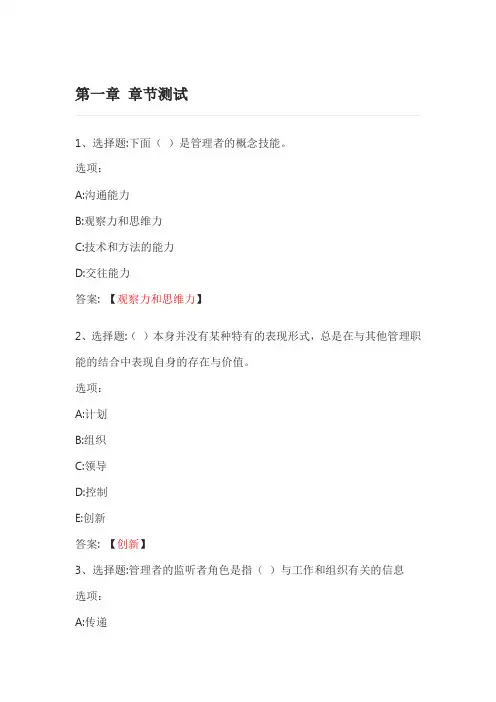
1、选择题:下面()是管理者的概念技能。
选项:A:沟通能力B:观察力和思维力C:技术和方法的能力D:交往能力答案: 【观察力和思维力】2、选择题:()本身并没有某种特有的表现形式,总是在与其他管理职能的结合中表现自身的存在与价值。
选项:A:计划B:组织C:领导D:控制E:创新答案: 【创新】3、选择题:管理者的监听者角色是指()与工作和组织有关的信息选项:A:传递B:收集与获取C:发布D:听取答案: 【收集与获取】4、选择题:范蠡、计然曾提出了“水则资车、旱则资舟”,“夏则资裘,冬则资絺”,表明中国很早就有了()思想。
选项:A:计划B:决策C:组织D:控制答案: 【组织】5、选择题:学好管理学不一定能管理好企业,说明管理具有()。
选项:A:科学性B:经济性C:艺术性D:人本性答案: 【艺术性】1、选择题:管理理论是在对( )观察和认识的基础上形成管理思想,管理思想经过提炼、概括与总结形成(),同时又对管理实践进行指导。
选项:A:人类社会活动B:经济活动C:管理理论D:管理实践活动答案: 【管理理论,管理实践活动】2、选择题:亚当·斯密在《国富论》中提出()。
选项:A:“经济人”观点B:“社会人”观点C:分权管理D:劳动分工论答案: 【分权管理,劳动分工论】3、选择题:法约尔认为管理的职能包括()。
选项:A:计划B:组织C:指挥D:控制E:沟通答案: 【计划,组织,指挥,控制】4、选择题:马斯洛需要层次理论认为人的需要是有层次的,由低到高分为()。
选项:A:生理需求B:安全需求C:社交需求D:尊重需求E:自我实现需求答案: 【生理需求,安全需求,社交需求,尊重需求,自我实现需求】5、选择题:古典管理理论的代表有( )。
选项:A:泰勒B:法约尔C:德鲁克D:韦伯E:马斯洛答案: 【泰勒,法约尔,韦伯】1、选择题:管理的基本原理主要包括()选项:A:系统原理B:人本原理C:责任原理D:效益原理E:伦理管理答案: 【系统原理人本原理责任原理效益原理伦理管理】2、选择题:责权利三角定理主要涉及()因素选项:A:权限B:利益C:能力D:职责E:工作答案: 【权限利益能力职责】3、选择题:研究管理原理的意义在于( )选项:A:提高管理工作的科学性B:掌握管理的基本规律C:有助于找到解决管理选择题的途径D:有助于找到解决管理选择题的手段E:有助于提炼管理理论答案: 【提高管理工作的科学性掌握管理的基本规律有助于找到解决管理选择题的途径有助于找到解决管理选择题的手段】4、选择题:人本原理包括以下观点()选项:A:职工是企业的主体B:有效管理的关键是职工参与C:现代管理的核心是让人走向完美D:管理是为人服务E:管理的前提是有群体答案: 【职工是企业的主体有效管理的关键是职工参与现代管理的核心是让人走向完美管理是为人服务】5、选择题:管理者履行职责能否做到完全负责主要取决于()因素选项:A:权限B:利益C:能力D:学历E:经验答案: 【权限利益能力】1、选择题:某企业为了建设企业文化组织员工去天安门广场观看升国旗,唱国歌,这属于管理()选项:A:法律方法B:行政方法C:教育方法D:技术方法E:经济方法答案: 【教育方法】2、选择题:强制性是管理的()方法的特点选项:A:法律方法B:行政方法C:经济方法D:教育方法E:技术方法答案: 【法律方法经济方法】3、选择题:下列方法中客观性与精确性最强的是()。
管理学原理各章练习第一章管理与管理学一、单项选择题1.层次越高的主管人员,对___D___的要求越高.A.技术技能B.人事技能C.管理技能D.概念技能2.管理的主体是( D )A.企业家B.全体员工C.高层管理者D.管理者3管理是一门应用性科学,是指管理的(D )A一般性B多样性C历史性D实践性4.管理作为一门艺术,是强调管理的_____A_____A.实践性B.精确性C.系统性D.理论性5.管理的载体是( D )A.管理者B.技术C.工作D.组织6.管理的核心是( C )A.建立组织机构B.协调人力物力C.协调人际关系D.尽力减少支出7.管理的核心是___B___.A.决策B.处理好人际关系C.组织D.控制8.管理的核心是( A )A.处理好人际关系B.制定目标C.管理好管理者D.实施控制9.管理的核心是( D )A.决策B.领导C.激励D.处理好人际关系10.在学习、研究管理学的方法论中,起总的指导作用的是( C )A.系统方法B.理论联系实际的方法C.唯物辩证法D.比较分析法11.管理的第一次转折是___B___科学管理理论的出现A.法约尔B.泰罗C.卢瑟D.马歇尔12._____A___是马克思主义关于管理问题的基本观点.A.管理的两重性B.管理的一般性C.管理的多样性D.管理的实践性13.管理学应属于( A )A.边缘科学B.经济学C.社会科学D.自然科学14.管理的载体是___C___A.管理者B.技术C.组织D.工作15.管理学的第二次大转折发生于_____D____A.19世纪末B.产业革命C.第二次世界大战中军需准备时期D.第二次世界大战后电子技术迅速发展时期16.管理内部的要素,一般是___D______A.不可控制B.部分可控C.部分不可控D.可以控制17.管理的两重性是指管理的______B___A.自然属性和历史属性B.自然属性和社会属性C.经济属性和技术属性D.连续属性与间断属性18.研究管理学的总的方法论指导是___C____A.系统方法B.理论联系实际的方法C.唯物辩证法D.比较分析法19.一般来说,组织的外部要素是( C )A.可以控制的B.无法控制的C.部分可以控制的D.不可以控制的20.发展中国家经济落后,关键是____C_____落后A.技术B.体制C.管理D.科学21.在组织的五个基本要素中,管理的媒介是( B )A.人与物B.信息C.机构D.目的22.在组织的内部要素中,表明为什么要有这个组织的要素是( D )A.人与物B.信息C.机构D.目的23.管理的主体是( A )A.管理者B.组织C.人D.管理机构24.管理的主体是___D____A.员工B.国家C.领导D.管理者25.美国管理学家彼德·德鲁克认为,管理者的第一个责任是( B )A.管理管理者B.管理一个组织C.管理工作和工人D.从事管理活动26.管理过程中的首要职能是( C )A.人员配备B.组织C.计划D.指导与控制27.管理的五大基本职能是____B____A.计划、组织、协调、领导、控制B.计划、组织、人员配备、指导与领导、控制C.计划、协调、指导、人员配备、控制D.组织、人员配备、指导与领导、控制、协调28.马克思主义关于管理问题的基本观点是( B )A.辩证唯物主义观点B.管理二重性观点C.系统的观点D.发展的观点29.反映管理同生产力、社会化大生产相联系的属性是( C )A.社会属性B.艺术性C.自然属性D.科学性30.管理学原理区别于专门管理学的特点在于( C )A.历史性B.科学性C.一般性D.实践性31.管理学属于边缘学科,这说明管理学的特点是( B )A.一般性B.多样性C.实践性D.历史性32.管理学研究的侧重点或主线是( C )A.社会生产方式B.管理历史C.管理过程及职能D.资源配置33.具有消亡倾向的系统是( B )A.开放系统B.封闭系统C.子系统D.反馈系统34.在自动调节系统中,为使工作维持在规定工作状况下而采取的措施,叫作( a )A.控制B.协调C.反馈D.交换35.在一个社会系统内,可以用不同的输入或不同过程去实现同一目标,这是系统的( D )观点.A.整体B.信息反馈C.不断分化和完善D.等效36.现代社会文明发展的三大支柱是:科学、技术和(D )A.资源B.生产力C.泰罗制D.管理37.管理是一种( C )A.经济现象B.自然现象C.社会文化现象D.科学现象38.管理是生产过程固有的属性,是指_____B___A.管理的目的性B.管理的必要性C.管理的科学性D.管理的民主性39.下列管理层次中____B____的职能是按照规定的计划和程序,协调基层组织的各项工作和实施计划.A.上层B.下层C.中层D.经营管理层40.中层主管人员主要任务是____B______A.监督执行B.协调执行C.决策控制D.激励员工41.主管人员的层次划分是指( D )A.内层外层B.深层浅层C.表层里层D.上中下层42.决定学习、研究管理学必要性的是( C )A.管理的自然性B.管理的社会性C.管理的重要性D.管理的历史性43.上层主管人员的重要任务是( D )A.监督执行B.协调执行C.监督控制D.决策控制44.管理直接或间接地同生产资料所有制有关,反映了管理的_____B____A.必要性B.目的性C.科学性D.艺术性23._____D____是主管人员最基本的准则A.有强烈的管理愿望B.掌握大量的管理理论C.以公司利益为准则D.尽职尽责29.主管人员的权力很大程度上表现的是____D_____A.能力B.素质C.物质基础D.自主程度二、多项选择题1.管理者在管理过程中承担的职能是( ACDE )A.计划B.预测C.组织D.控制E.指导与领导2.管理的二重性是指管理的( CD )A.科学性B.艺术性C.自然属性D.社会属性E.实践性3.管理的基本特征有__ABCE_____A.管理是一种社会现象B.管理是一种文化现象C.管理的主体是管理者D.管理的核心是决策E.管理的核心是处理好人际关系4.管理的客体是( ABE )A.人B.信息C.机构D.目的E.物5.美国管理学家彼德·德鲁克认为,管理者的责任是( ABD )A.管理一个组织B.管理管理者C.实现管理目的D.管理工作和工人E管理计划过程6.一个组织通常划分为如下层次( BE )A.主管层、执行层和作业层B.经营决策层、执行管理层和监督作业层C.经营管理层、外部管理层和核心管理层D.经营决策层、监督作业层和执行管理层E.上层、中层和基层7.管理是一种社会文化现象,其存在的必要条件是( BD )A.管理理论B.一致目标C.管理实践D.集体活动E.管理原理8.虽然组织的类型、形式和规模可能各有差异,但其内部都含有以下基本要素( ABDE )A.人与物B.信息C.管理D.机构E.目的9.管理的基本特征是( BCDE )A.具有内部基本要素和外部环境要素B.主体是管理者C.具有任务、职能和层次D.核心是协调人际关系E.是一种文化现象和社会现象10.管理的两重性反映出管理的( BE )A.科学性和艺术性B.必要性和目的性C.部分可控性和部分不可控性D.技术性和阶级性E.生产力属性和生产关系属性11.管理的社会属性体现着生产资料所有者指挥劳动、监督劳动的意志,因此管理与下列因素相联系( BD )A.生产力B.生产关系C.社会化大生产D.社会制度E.科学技术12.管理学作为一门不精确的、有待于发展的科学,具有以下特点( ACDE )A.一般性B.专业性C.多样性D.历史性E.实践性13.推动现代社会发展的、缺一不可的“两个轮子”是( CE )A.丰富的资源与先进的技术B.科学技术与管理人才C.先进的科技D.发达的科技与管理水平E先进的管理14.学习与研究管理学的一般方法有以下三个( ABD )A.唯物辩证法B.系统方法C.科学管理方法D.理论联系实际方法E.管理过程方法15.从管理的角度看,系统包含有两个含义,它们分别是( BD )A.系统是一个有机整体B.系统是一个实体,例如组织C.系统从属于环境超系统D.系统是一种方法或手段E.系统的维持依赖于反馈信息16.当把管理过程或活动看作实体的系统时,它具有如下几个特征( ABCDE )A.整体性B.目的性C.开放性和交换性D.相互依存性E.控制性17.学习和研究管理学的具体方法有( BCDE )A.系统方法B.比较法C.案例分析法D.综合法E.分析法18.管理逐渐形成理论并得到重视,在历史上经历过二次大的转折,它们是( AD )A.泰罗制的出现B.社会化大生产的出现C.十月革命以后D.第二次世界大战以后E.工业革命以后19.管理学研究生产力方面的内容包括( AE )A.组织中人、财、物的配置问题B.调动各方面积极性与创造问题C.环境适应问题D.产权问题E.寻求最佳经济效益与社会效益问题20.管理学所研究的生产关系方面的内容包括( AC )A. 组织内部人际关系问题B.合理配置人财物问题C.完善组织机构与管理体制问题D.使规章制度与上层建筑保持一致问题E.环境适应问题三、名词解释管理学;系统;系统的方法;主管人员;四、问答题系统的特征15;系统的观点及其内容;管理的基本特征;科学技术与管理的关系;掌握管理的两重性,对于学习管理学和从事管理工作的意义;管理学的特点;为什么要学习、研究管理学;学习和研究管理学的方法;五、论述题如何理解管理既是一门科学又是一门艺术,实际工作中如何运用;管理二重性及其现实意义6;第二章管理学的形成一、单项选择题1.泰罗的科学管理理论出现在( A )A.19世纪末20世纪初B.20世纪初30年代C.20世纪40年代D.20世纪60年代2.泰罗认为工人和雇主双方都必须来一次( D )A.管理培训B.管理实践C.劳动竞赛D.心理革命3.新古典管理理论的形成发展主要是( C )A.从18世纪到19世纪末B.从20世纪初到20世纪30年代C.从20世纪30年代到20世纪60年代D.从20世纪60年代至今4.马克斯韦伯的理论属于_____A______A.理想行政组织体系理论B.人际关系理论C.科学管理理论D.行为科学理论5.古典管理理论阶段的代表性理论是( A )A.科学管理理论B.管理科学理论C.行为科学理论D.权变理论6.在“管理科学理论”中,首先提出“系统分析”概念的是__C__.A.日本松下电器公司B.德国西门子公司C.美国兰德公司D.美国通用公司7.霍桑试验提出要重视管理中( B )A.物的因素B.人的因素C.工程技术方面因素D.人\事\物的结合8.泰罗是__B____--的代表人物之一A.管理萌芽阶段B.古典管理理论阶段C.新古典管理理论阶段D.现代管理理论阶段9.管理学形成的标志是____B______A.法约尔管理过程理论的出现B.泰罗科学管理理论的出现C.马克斯•韦伯组织理论的出现D.梅奥行为科学理论的出现10.科学管理的中心问题是____D____A.作业标准化B.计划工资制C.心理革命D.提高劳动生产率11.被称为组织理论之父的是____D_____A.泰罗B.萨伊C.法约尔D.韦伯12.马基雅维利的两类型领导者是指____A_______A.自然或天生型、后天获得型B.自然或天生型C.聪明和后天获得型D.内向和外向型13.古典管理理论中,把人视为_____A____A.经济人B.复杂人C.社会人D.自我实现人14.行为科学理论的形成和发展,处于管理学形成的___D____阶段.A.早期阶段B.萌芽阶段C.古典管理理论阶段D.新古典管理理论阶段15泰罗科学管理理论出现于(C )阶段。
《管理学原理》习题集参考答案第一章简答题1、随着市场环境急剧变化,创新成为企业生存的一项重要职能,管理者应如何处理创新和维持企业平稳运作的关系?答:树立创新的观念是企业生存的基本要求,企业管理者应在保证企业运作平稳的前提下,从以下几方面为创新创造条件:(1)始终追踪、及时发现环境的变化。
(2)制定长期发展战略,将企业的长期平稳运作和创新均纳入战略。
(3)建立灵活的组织结构,增强对环境的适应能力。
(4)建立有利于创新的组织文化。
2、管理的有效性体现在什么地方?(“正确地做正确的事”表明对管理的何种要求?)答:(1)管理的效果要求实现组织目标(2)管理的效率要求对组织资源进行优化配置(3)管理追求的是效率与效果的统一,即效率与效果的双重优化(4)管理有效性其实质是正确地作正确的事3、为什么说管理是有目的无目标的活动?(或管理是否可以独立存在?)答:(1)管理是服务于组织目标的实现的有意识、有目的的活动,管理的目的隶属和服务于具有特定使命和目标的组织(2)管理不具有自己的目标,不能为管理而管理,只能服务于组织目标的实现4、系统与权变管理思想的观点是什么?有何价值?答:(1)组织是一个由相互依存的众多要素构成的开放系统(2)强调环境或情景因素,需要根据具体的环境条件的不同而采取相应不同的管理方式(3)将研究的重点转移到对管理行动有重大影响的环境因素上(4)没有一成不变、普遍适用的管理理论与方法5、你如何理解企业经营发展中的“天时”、“地利”、“人和”?答:(1)“天时”主要是指国家的政策、外部机会等(2)“地利”包括地理位置、气候条件、资源赋存(3)“人和”包括“人”:人力资源(数量、结构)与“和”:团队、精神6、概念技能在组织高层管理人员制定战略决策中的作用体现在哪些方面?答:(1)概念技能是指综观全局,认清为什么要做某事的能力,也就是洞察企业与环境相互影响之复杂性的能力。
(2)战略决策是确定与企业发展方向和远景有关的大政方针政策,一般指时间较长,范围较大的全局性问题。
第一章管理与管理学一、单项选择题1.(P3)认为“管理就是决策”的学者是()A.赫伯特·A ·西蒙B.小詹姆斯·H·唐纳利C.弗里蒙特·E·喀斯特D.托尼·布洛克特2.(P5)管理的载体是()A.管理者B.技术C.工作D.组织3.(P5)管理的主体是()A.企业家B.全体员工C.高层管理者D.管理者4.(P6)管理的任务就是设计和维持使人们能够用尽可能少的支出去实现既定目标的()A.氛围B.环境C.制度D.体制5.(P6)管理者的层次划分是指()A.表层、里层B.上层、中层、基层C.内层、外层D.深层、浅层6、(P7)管理是一种艺术, 这是强调管理的()A.复杂性B.有效性C.实践性D.精确性7、(P8)管理直接或间接生产资料所有制有关, 这反映了管理的()A.科学性B.艺术性C.必要性D.目的性8、(P8)管理的两重性是马克思主义关于管理问题的基本观点, 它反映的是()A、A.经济性和目的性 B.必要性和目的性 C 经济性和必要性 D 有效性和经济性B、9、(P8)管理是生产过程固有的属性, 是有效地组织劳动所必需的, 反映了管理的()科学性 B.艺术性 C.必要性 D.目的性10、(P11)管理学中的原理和方法适用于各种类型组织, 说明管理学具有()A.一般性B.多样性C.历史性D.实践性11.(P12)管理学的学科性质是()A.社会科学B.经济学C.边缘科学D.自然科学12、(P17)在学习、研究管理学的方法中, 起总的指导作用的是()A.系统方法B、理论联系实际的方法C、唯物辩证法D、比较分析法二、多项选择题1.(P5)德鲁克认为管理者在组织中应承担的责任包括()A.管理一个组织B.管理管理者C.管理工作和员工D.决策E、计划2.(P8)管理的二重性是指管理的()A.科学性B.艺术性C.自然属性D.社会属性E、实践性3、(P13)根据管理活动总是在一定生产方式下进行的, 其研究内容包括A.生产力方面B.生产关系方面C.上层建筑D.经济基础E、社会关系4.(P17)学习和研究管理学的一般方法有()A、A.唯物辩证法 B.直观法 C.因果法 D.系统方法E、理论联系实际的方法B、5.(P19)系统的特征有()目的性 B.交换性C、控制性D、相互依存性E、开放性三、名词解释1.(P4)管理: 是指组织中的管理者, 通过实施计划、组织、人员配备、领导、控制等职能来协调他人的活动, 使他人同自己一起实现既定的目标的活动过程。
第一章管理、管理者与管理学一、单项选择题1.C2.B3.D4.C5.D二、多项选择题1.ABDE2.BCDE3.BCE4.ACDE5.ABCDE三、判断题1.×2. ×3.√4.×5. ×四、简答题1.简述组织的含义和类型。
组织是具有既定目标和正式结构的社会实体。
“社会实体”指组织是由两个或两个以上的人组成的;“既定目标”指组织要获得的预期效果;“正式结构”指组织任务是由组织成员分工协作完成的。
按照组织的社会功能划分,可分为经济组织、政治组织、文化组织和群众组织。
按组织的基本性质划分,可分为营利性组织和非营利性组织。
2.管理的含义是什么?管理是在一定环境中,组织中的管理者通过实施计划、组织、领导和控制等职能,有效地利用各种资源,以达到组织目标的过程。
这一定义包括以下含义:(1)管理是在一定的环境中进行的。
(2)管理是在一定的组织中进行的。
(3)管理的主体是管理者。
(4)管理的客体是组织中的各种资源。
(5)管理是一个过程。
(6)管理的目的是实现组织的目标。
3.简述管理职能和管理过程。
管理是由计划、组织、领导、控制这四个职能构建起来的。
管理是一个围绕实现组织目标而展开的复杂过程。
计划、组织、领导、控制四个职能构成了管理过程。
这个过程以计划为起点,制定好计划后,就要对组织内各构成素和活动进行组织,继而实施领导,然后对计划执行情况和组织运行情况进行控制,最后实现计划目标,这样就完成了一个管理过程。
之后再提出新的计划目标,开始新的循环。
管理过程就是这样一个不断地周而复始的运动过程。
4.为什么环境研究对于管理十分重要?任何组织的管理活动都是在一定的环境中进行的,要受到各种各样环境因素的影响。
一个组织要在特定的环境中生存和发展,就必须了解其所处的环境,并及时掌握环境的变化,分析、确定环境因素对组织的影响,针对各种环境因素的影响制定相应的对策,采取与环境变化相适应的管理形式和方法。
第二章管理理论的形成与发展✧考情提要第二章 管理理论的形成与发展题型/题量单选多选判断说明简答题论述题案例分析题总计(分)2015(10)113 2016(4)0 2016(10)114 2017(4)114 2017(10)1119✧逐题击破一、选择题1.梅奥的人际关系学说属于()【单选】A.行为科学理论B.科学管理理论C.一般管理理论D.权变管理理论2.第一次提出管理五要素的是()【单选】A.梅奧B.法约尔C.西蒙D.泰勒3.梅奥领导的霍桑试验得出了生产效率的高低主要取决于工人的态度等一系列结论,并在此基础上创立了()【单选】A.古典管理理论B.人际关系理论C.决策理论D.系统管理理论4.提出“标准化原理”的学者是()【单选】A.法约尔B.泰勒C.梅奥D.马斯洛5.在历史上第一次使管理从经验上升为科学的是()。
【单选】A.科学管理理论B.管理科学理论C.管理过程理论D.行为科学理论6.“任何组织都必须以某种权力作为基础,才能实现目标,只有权力,才能变混乱为秩序。
”反映这一观点的理论是()【单选】A.泰勒的科学管理理论B.巴纳德的社会合作理论C.韦伯的行政组织理论D.西蒙的决策理论7.马克思•韦伯的理论为分析实际生活中各组织形态提供了一种规范模型,这种理论是()A.科学管理理论B.行为科学理论C.管理科学体系D.理想的行政组织体系8.在现代管理理论学派中,认为企业管理没有什么一成不变、普遍使用的“最佳的”管理理论和方法的学派是()。
【单选】A.管理过程学派B.行为科学学派C.系统管理学派D.权变理论学派9.满意决策中“满意”标准的提出者是()【单选】A.泰罗B.西蒙C.孔茨D.韦伯10.通过分析、比较和研究各种各样成功和失败的管理经验,抽象出管理的一般性的结论或原理的是哪一个学派的观点?()【单选】A.社会合作学派B.经验或案例学派C.决策学派D.权变学派11.战略管理理论的特点是()。
【单选】A.标准化、制度化B.长远性C.全面性、系统性、精确性D.重视人的因素12.古典管理理论主要是由以下哪几个学派构成的?()【多选】A.科学管理理论B.一般管理理论C.行政组织理论D.行为科学理论E.决策理论13.以下属于亚当·斯密的观点的是()【多选】A.提出了分工协作原理B.提出了生产合理化原理C.提出了“经济人”观点D.提出了“边际熟练原则”E.提出了“管理的机械原则”14.古典管理理论的主要特点()。
1、选择题:管理者出席社区的集会或参加社会活动时,所行使的是()的角色选项:A:代表人B:联络者C:发言人D:谈判者答案: 【代表人】2、选择题:()是管理的首要职能选项:A:计划B:组织C:领导D:控制答案: 【计划】3、选择题:()被称为“科学管理之父”。
选项:A:亚当·斯密B:罗伯特·欧文C:亨利·法约尔D:泰罗答案: 【泰罗】4、选择题:越是处于高层的管理者,其对于概念技能、人际技能、技术技能的需要,就越是按()顺序排列选项:A:概念技能,技术技能,人际技能B:技术技能,概念技能,人际技能C:概念技能,人际技能,技术技能D:人际技能,技术技能,概念技能答案: 【概念技能,人际技能,技术技能】5、选择题:斯密认为人是选项:A:理性人B:社会人C:经济人D:复杂人答案: 【经济人】6、选择题:()被称为是“人事管理之父”。
选项:A:亚当·斯密B:亨利·法约尔C:罗伯特·欧文D:泰罗答案: 【罗伯特·欧文】7、选择题:法国管理学家法约尔在其《工业管理与一般管理》一书中把管理的职能分为()选项:A:计划B:组织C:指挥D:协调E:控制答案: 【计划,组织,指挥,协调,控制】8、选择题:韦伯认为()权威是理想组织形式的基础。
选项:A:个人崇拜式B:理性—合法式C:传统式答案: 【理性—合法式】9、选择题:梅奥对其领导的霍桑试验进行总结,认为工人是()选项:A:经济人B:社会人D:复杂人答案: 【社会人】10、选择题:霍桑试验表明生产效率的高低还受到工人的态度、积极性以及工人的家庭、社会生活、组织中人与人需求等影响。
选项:A:对B:错答案: 【对】1、选择题:决策所遵循的原则是()选项:A:最优原则B:实用原则C:科学原则D:满意原则答案: 【满意原则】2、选择题:决策的依据是()选项:A:完全信息C:少量信息D:与信息无关答案: 【适量信息】3、选择题:西蒙把决策活动分为程序化决策与非程序化决策两类,二者区分标准是:()选项:A:经营活动与业务活动B:例行选择题与非例行选择题C:最优标准或满意标准D:计算机决策或非计算机决策答案: 【例行选择题与非例行选择题】4、选择题:某一决策方案,只有一种执行后果并能事先测定,此种类型的决策称为()选项:A:确定型决策B:风险型决策C:非肯定型决策D:概率型决策答案: 【确定型决策】5、选择题:将对某一选择题有兴趣的人集合在一起,在完全不受约束的条件下,敞开思路、畅所欲言的决策方法是()选项:A:因果分析法B:名义小组法C:德尔菲法D:头脑风暴法答案: 【头脑风暴法】6、选择题:选取若干专家,以函询方式请专家们独立书面发表意见,并几经反馈的方法,称为()选项:A:德尔菲法B:通讯预测法C:名义小组法D:头脑风暴法答案: 【德尔菲法】7、选择题:决策应遵循最优原则选项:A:对B:错答案: 【错】8、选择题:决策时,获得的信息越多越好。
第二编一、填空题:1、__计划__是管理的首要职能,它是确定组织的__目标____和实现__目标___的方式。
2、预测是根据__过去__和_现在____预计__未来__、根据_已知__推测__未知___的过程;预测的目的是为了___科学决策_____;___需求与资源、机遇与风险___是任何一个组织需加预测的基本内容。
3、按时间跨度来分,预测可分为_短期__、_中期__、__长期__。
4、预测方法可分为两类,一类是_定性__,一类是___定量___;德尔菲法也叫__专家预测法_____,属于__定性______预测法。
5、假定下一期需求与最近一期需求相同的定量预测法叫__朴素预测法_______。
6、平滑系数值是根据以往的___实际量____与__预测量___之间差异的大小而异,一般在__0___到___1_____之间选定。
7、___目标管理________是美国管理学家彼得•德鲁克于1954年提出的一种综合管理方法,其主要特点是:强调以__目标_________为中心的管理,强调以_____目标网络________为基础的系统管理,强调以_____人__________为中心的参与式管理。
8、实行MBO,就是要___以企业总目标________以来规划各部门、各岗位的工作。
9、MBO的实施程序主要分为__制定目标____、__实施目标_______和___考核评价______三个阶段;10、决策就是组织或个人为了__实现某种目标_______而对未来一段时期内有关活动的方向、内容及方式的_选择_______或____调整________过程。
11、决策的前提是___有所选择_________,决策的实质是_作出决定________;决策是___计划__________的核心环节,也是___管理________的核心环节。
12、按决策的时间划分可分为__长期战略________决策和___短期战术________决策;按决策的可确定程度划分可分为__确定型______决策、___风险型________决策和__非确定型_________决策。
13、常用的定量决策方法有____确定型_______决策法、__风险型_________决策法、_____非确定型__________决策法.14、量本利分析法的中心内容是_____盈亏平衡点分析___________的分析。
15、边际贡献是产品销售收入与__全部变动成本_____的差额,利润是边际贡献大于__固定成本________的部分。
16、小中取大法叫__悲观_____决策法,大中取大法叫___乐观___决策法,后悔值决策法也叫__大中取小_决策法。
17、先_宗旨____,后目标;先战略,后_战术____;先长远,后_近期_____是制定计划必须遵循的次序。
18、计划的具体化可概括为“5W1H”,即_Why_____、__When____、__Where___、_What____、__Who____、___How______。
二、选择题:1、在整个管理工作中处于首要位置的是A、计划B、组织C、领导D、控制2、对于风险型决策,最常用的方法A、决策树B、最小后悔值法C、量本利分析法D、边际贡献法3、对未来持悲观态度、比较谨慎的决策者在进行不确定型决策时,一般采用A、小中取大法B、小中取小法C、大中取大法D、大中取小法4、决策过程中的“拍板”是指A、确定决策目标B、确定价值指标C、方案优选D、方案实施5、由组织最高层管理者所作的决策是A、程序化决策B、业务决策C、战略决策D、管理决策6、计划工作一般起始于A、目标制订B、机会估量C、计划审订D、方案选择7、下列几项,哪一项不属于计划的范畴?A、课程表B、规章制度C、统计报表D、工作流程8、MBO认为,有效管理的首要前提是需要有明确的A、宗旨B、政策C、目标D、战略9.狭义的计划指的是()。
A.执行计划B.制定计划 C.计划准备D.检查计划10.涉及计划工作的基本特征的下列各种说法中,错误的是:()。
A.计划工作的普遍存在B.计划工作居首要地位C.计划是一种无意识形态 D.计划工作要讲究效率11.基本建设计划、新产品开发计划等属于()计划。
A.综合B.专项C.生产 D.财务12.()也被称为数字化的计划。
A.政策B.目标 C.规则D.预算13.计划工作的核心是()。
A、组织B、决策C、预测 D.领导14.战略性计划一般由()负责制定。
A、董事会B、高层管理人员C、中层管理人员 D.基层管理人员15.公司政策规定工作人员享有假期,为实施这项政策公司编制了度假时间表,制订了假期工资率、支付办法,以及申请度假的详细说明,这属于()。
A、规划B、程序C、策略D.规则16.年度计划一般属于()计划。
A、生产B、长期C、中期 D.短期17.首先把目标管理作为一套完整的管理思想提出的是()。
A、泰罗B、梅奥C、赫伯特·西蒙D、彼得·德鲁克18.管理学家彼得·德鲁克认为,单纯强调利润会使经理人迷失方向以至于危及企业的生存,因此他提出,企业目标唯一有效的定义就是()。
A、技术创新B、信誉至上C、创造顾客D、质量优良19.目标的确定要建立在对企业内外环境进行充分分析的基础上,并通过一定的程序加以确定,既要保证目标的科学性又要保证其可行性。
这就是确定目标的()原则。
A、现实性B、可行性C、程序性D、权变性20.在目标设立过程中,以下哪种作法是不对的?()。
A、尽可能量化企业目标B、把目标控制在五个以内C、目标期限应以长期目标为主D、期限适中21.一些学者提出,企业在追求利润最大化的过程中,由于各种内外因素的限制,人们只能得到()。
A、适当利润B、满意利润C、最大利润D、理想利润22.通过对目标变迁的分析,我们有理由相信,()是成功管理的直观标志,也是企业的永恒追求。
A、创造利润B、成功决策C、企业长寿D、最大利润23.企业目标具有变动性,第二次世界大战以后,()的企业目标日益普及。
A、利润目标B、顾客至上C、融入社会责任D、满意利润24.目标不是一成不变的,一般来说,()应保持一定的稳定性。
A、利润目标B、短期目标C、中期目标D、长期目标25.管理学家()从行为科学的角度研究目标管理,提出:工作成果=决策的质量×激发人们履行决策的动机。
A、E·C·施勒B、彼德·德鲁克C、D·麦格雷戈D、R·利克特26.目标管理思想诞生于美国,但最早将目标管理理论应用于管理实践的国家是()。
A.德国 B.法国 C.日本D.英国27.根据过去和现在的已知因素,运用人们的知识、经验和科学方法,对未来进行预先估计,并推测事物未来的发展趋势的活动过程,称为()。
A、预测B、定性预测C、决策D、计划28.如果要对事物发展变化的未来趋势作出描述,例如对五年后技术变革方向进行预测,通常采用()的方法。
A、市场预测B、经济形势预测C、定性预测D、定量预测29.在进行产品价格决策时,需要做的是()。
A、长期预测B、中期预测C、短期预测D、定性预测30.在预测过程中,如果缺乏或难以获取足够数据的资料,而主要运用个人的经验和知识进行判断,这时需要采用()。
A、简单平均法B、定性预测法C、定量预测法D、时间序列法31.选择适当的预测方法对于提高预测的准确性和预测的效率十分重要。
因此,预测者要根据预测的目的和预测对象的性质选择合适的预测方法。
如进行技术预测,往往采用()。
A.时间序列法B.头脑风暴法 C.回归分析法D、专家调查法32.定量预测是运用数学模型对事物未来的发展趋势作出定量、具体描述的方法。
它需要完整有效的()作基础。
A.科学技术B.模拟试验室 C.信息D、数据资料33.某企业试图改变其经营方向,需要企业高层领导做出决策,这种决策属于()。
A、战略决策B、战术决策C、业务决策D、程序化决策34.该项决策具有极大偶然性和随机性,又无先例可循且有大量不确定因素,其方法和步骤也难以程序化和标准化,这项决策就是()。
A、风险型决策B、不确定型决策C、程序化决策D、非程序化决策35.业务决策中,例如生产任务的日常安排、常用物资的订货与采购等诸如此类的经常重复发生,能按原已规定的程序、处理方法和标准进行的决策,属于()。
A、日常管理决策B、程序化决策C、确定型决策D、风险型决策36.在确定决策目标时,要注意把目标建立在()的基础上。
A、需要B、可能C、需要和可能D、必要的利润37.例外决策,具有极大偶然性、随机性,又无先例可循且具有大量不确定性的决策活动,其方法和步骤也是难以程序化、标准化,不能重复使用的。
这类决策又称为()。
A、风险型决策B、不确定型决策C、战略决策D、非程序化决策38.假如各种可行方案的条件大部分是已知的,但每个方案执行后可能出现几种结果,方案的选择由概率决定。
那么,这种决策属于()决策。
A、风险型B、不确定型C、确定型D、非程序化决策39.决策程序的首要环节是()。
A、确定决策原则B、确定决策方法C、确定决策目标D、拟定可行方案40.某企业生产某种产品,固定成本为20万元,单位可变成本为100元,每台售价200元,则该产品的盈亏平衡点产量是()。
A、400台B、2000台C、4000台D、20000台41.某公司的固定成本为300万元,单位可变成本为40元,产品单位售价为55元,那么,当该企业的产量达到20万件时,其总成本为()万元。
A.110 B.1010 C.1100 D.1100042.某企业在下年度有甲、乙、丙三种产品方案可供选择,每种方案都面临畅销、较好、一般和滞销四种状态,每种状态的概率和损益值如下表所示:那么,用决策树法选出的最优方案是()方案。
A.甲 B.乙 C.丙 D.甲和乙43.某企业拟开发新产品,有三种设计方案可供选择,各种方案在各种市场状态下的损益值如下表所示:单位:万元那么,用冒险法选取的最优方案为()。
A.甲 B.乙 C.丙 D.甲和乙三.判断正误并改正1.决策工作是进行组织、人员配备、指导与领导、控制等工作的基础。
N2.计划是对企业内部不同部门和成员在该一定时期内具体任务的安排,他详细规定了不同部门和成员在时期内从事活动的具体内容和要求。
Y3 / 103.程序是思想的指南。
N4.计划的效率是指从组织目标所做贡献中扣除制定和执行计划所需费用及其他因素后的总额,所以,在制定计划时,我们应该考虑包括计划的经济方面的利益和非经济方面的利益和损耗。
Y5.政策是指在决策或处理问题时指导及沟通思想活动的方针和一般规定,政策必须保持灵活性和及时性。
N 6.程序是对具体场合和具体情况下,允许或不允许采取某种特定行动的规定。